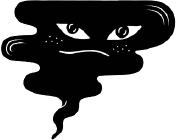

S.E. Hinton · Robert Cormier · Judy Blume · Richard Adams · Roald Dahl
SCIENCE FICTION’S SPECULATIVE FUTURES TELL US about the present. Fantasy is about the real world. Ghost stories are always about our own fears. It is primarily through those genres that children’s literature has obliquely dealt with, where it has not outright avoided, the disturbances and terrors of the middle of the twentieth century. Perhaps because of that, and because of the association of magic with fairy stories, it has been half-assumed that these genres belonged to children’s literature. Even grown-up fantasy and science-fiction writing sometimes struggles to be taken seriously, to be seen as quite grown up. There’s a certain amnesia in that, as I hope I’ve made clear: the earliest stories were fantasies and fables and myths, and they only latterly came to be relegated to the nursery.
But even as these stories were flourishing, something else started to happen in the late 1960s and early 1970s: another swerve in the temper of the times, the waking of a greater appetite for a form of realism in children’s writing. I don’t just mean realism strictly as a literary-critical term. In the sense that the Famous Five and the Secret Seven contained no elements of the supernatural, you could call them realist fiction; yet they were representing a version of reality no less fantastical, in its way, than the Narnia stories. The realism that started to creep into children’s fiction in the last quarter of the twentieth century was one that was interested in representing children to themselves not as they (or adults) might dream of them being, but as they were.
That is, they would start to represent children who weren’t middle-class, who didn’t have two parents, who didn’t enjoy bucolic summer-hols adventures, and above all who might experience violence and the stirrings of sexuality. As the 1970s dawned, that sort of realism was budding – perhaps surprisingly, as the defining image of the time came to be flower-festooned hippies wafting around San Francisco – in the United States. The works of Robert Cormier, S.E. Hinton, and Judy Blume brought a hard edge of recognizably realworld adolescent sexuality, violence and cruelty into mainstream fiction for young readers. And all of them, accordingly, activated adult outrage to the extent that all have been paid the dubious compliment of appearing multiple times in the American Library Association’s lists of “Most Challenged Books” – i.e. the ones that have been targeted for removal from libraries or school curricula.
The stage had been set as early as 1944, when the phrase “young adult” first appeared in the title of an annual newsletter about books for young people sent from the New York Public Library to schools and libraries across the States. A publishing niche – one that covered the transition from children’s books to grown-up reading material – had been identified. The idea of adolescence as a distinct phase of life (the term “teenager” came into general use in the 1940s) was taking hold on both sides of the Atlantic. The emergence of this category, a step away from the putative innocence of childhood, but adrift from the orderly world of adulthood, both fascinated and unsettled adult onlookers.
Stories about rebellious or dangerous teens filtered into some of the defining imaginative works of the 1950s, such as The Catcher in the Rye (1951), Lord of the Flies (1954), Rebel Without a Cause (1955), and West Side Story (1957). The perennial moral panic about “juvenile delinquency” – which can be found in most ages through history in one form or another – surged afresh. Teens had new clout as consumers, greater social freedoms, and a distinctive set of tribal identities in the emergent pop and rock ’n’ roll culture, even as the post-war baby boom reshaped Western demographics in the direction of the young.
In 1952 Enid Blyton, a leading voice of social conservatism in post-war English fiction, published a poem called “The Little Thug” in The Sunday Times:
So you had a gang and you swore and you spat,
But you’re not yet thirteen years old?
Poor little sallow, undersized brat,
You strutted so brave and so bold.
That little thug is voiceless in Blyton’s poem: fiction aimed at adolescents didn’t yet seek to inhabit the points of view of those teens who looked troubled, alienated or socially unacceptable. That was to change.